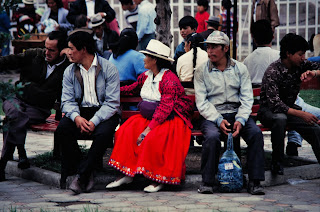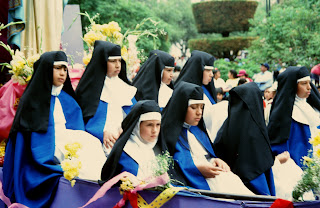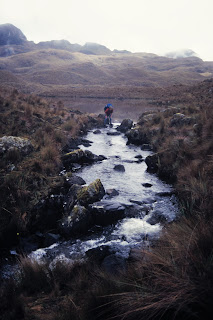The travelling child
Santa Ana de los Cuatro Ríos de Cuenca, in short Cuenca, is one of Ecuador’s largest cities. It is in the southern highlands at about 2,560 metres. The Spanish settlement was founded more than 20 years after the foundation of Quito (1534), on April 12, 1557 by the explorer Gil Ramírez Dávalos. It was named after the home town of the Viceroy of Peru of the time, Andrés Hurtado de Mendoza, in Spain. Cuenca's population and importance grew steadily during the colonial era, but its most important period was after it achieved independence in 1820, when it became the capital of one of the three provinces of Ecuador. Due to its many historical buildings the centre of the city is listed as a UNESCO World Heritage Site.
The strange extension on this building still exists today
Announcements of the christmas parade
Iglesia and monasterio del Carmen de la Asuncion, origin of the niño viajero
We arrived from Quito after an overnight bus trip. There had been a lot of rain and the road was in a deplorable state. The rivers were swollen, parts of the road were unpaved and muddy and in places even blocked by landslides or washed away. We were in constant fear that the vehicle would end up in one of the bottomless ravines which could be imagined beyond the edge of the road in the pitch black of the night.
Hostal Paredes
Although the city centre of Cuenca is full of historic palaces and mansions, in 1995 many were in a bad state. We find a room in one of the former mansions, now called hostal paredes. The former courtyard with an open gallery around the first floor which gave access to the rooms has been covered by a glass roof to create a nice common area. The once huge salons have been subdivided by thin walls. Maybe that gave the place its name. Even the subdivided rooms are spacious, with stucco decorations on the walls and high ornamented ceilings. I have tried to walk the streets of contemporary Cuenca in Google street view but I could not even find back the building. Our room was facing the street. Fortunately there were far less cars in the streets at the time, otherwise it would have been difficult to find sleep.
Inside Hostal Paredes
The hostal was not very far from Parque Calderon, the main square of historic colonial Cuenca. There are as many as three big churches at the square, the old cathedral of 1557, the iglesia and monasterio del Carmen de la Asuncion of 1682 and the Catedral de la immaculada concepcion, which was only finished in 1975 after almost a century of construction. The towers were never completed as it turned out that they would have been too heavy for the foundations. The old cathedral had become too small for the increasing population and after completion of the replacement was turned into a museum.
Catedral de la immaculada concepcion
Each year on December 24 the population of Cuenca celebrates one of the most important festivities in the province, the procession of the "Niño viajero” (Traveler Child) organised by the Monasterio del Carmen with the help of the archdioceses of Cuenca.
Police busy removing the last cars
In 1823 Doña Josefa Heredia commissioned a statue of the child Christ. Much later, in 1961, its owner at the time, Monsignor Miguel Cordero Crespo, took the image from the military hospital, where it was usually kept along on a pilgrimage to the Holy Land. In Bethlehem it was placed in a Nativity stall for a short time. When passing through Rome at the end of this journey, the Child was blessed by Pope John XXIII. When he came back to Cuenca Monsignor Miguel Cordero Crespo established the tradition of a Christmas parade and entrusted Rosa Palomeque with the organisation. The name was created when she first saw the image and exclaimed: "The traveler has arrived!"
Foodstalls are being set up in preparation of the parade
When Monsignor Miguel Cordero Crespo passed away in 1986 he left a will to entrust the sacred image of the Child God to the mothers of the Monastery of Carmen de la Asunción.
Stalls selling the popular roasted piglet
The great procession or "pass" generally begins at 10:00 am on Christmas day and ends at approximately 3:00 pm. The procession begins on Ordóñez Lazo Avenue and runs through Simón Bolívar Street, in the city center of Cuenca. Hours before the begin of the procession street vendors start to reserve their spots and organise their stalls.
Totally in accordance with Palestine tradition the most popular food, whole piglets, are roasted and sold to the spectators. But we are at the equator, so the scenery is not really like winter, and ice cream sellers dressed as Santa Claus push their carts.
The policia makes efforts to remove the last cars, which are parked in the way of the procession. People who make "last minute purchases", join those who line up to see the procession. There is a mix of city dwellers and paisanos, many of them Indians from the surrounding villages. Meanwhile some of the poor wait at the entrance gates of the churches for a gift or ask to get a bit of leftovers at one of the food stalls or bakeries.
Eventually the procession starts. The different barrios of the city have decorated colourful floats representing Christmas scenes. These allegorical chariots are built on large trucks that are covered with large curtains or fabrics. The scenes can be cribs of the Child God, The Adoration of the Shepherds, The Annunciation of Mary or the flight to Egypt. Some are decorated with straw mountains, clay pots or indigenous musical instruments.
Children are dressed in showy, colourful and elegant costumes to represent the richness of the parents. Others are dressed as biblical characters, shepherds, gypsies and different parts of the Ecuadorian ethnic groups. Some ride on mules or horses which are decorated with everything coveted by the parents, packages of cigarettes, bottles of booze, cans of food, fruit, chocolate or toys.
The participants bring along typical foods such as boiled potatoes, hard-boiled eggs, chili peppers, baked guinea pigs, turkeys, roast chickens and of course, the roasted piglets. Some of the piglets carry bank notes in their snouts. All will be devoured by the family after the procession is finished in a Christmas feast.
There are some characters which always come back in the procession. “El angel de la Estrella”, the angel of the star, is the star that guided the shepherds and magicians to Bethlehem. He is personified by a boy dressed as an angel with star headband, a white suit with wings, and a staff crowned by a star.
Of course there are the three wise men, “Los tres reyes magos”, Gaspar, Melchor and Baltazar. In Ecuador they represent the three racial groups of whites, blacks and Indians.
There always is the god child, “Niño Dios”, in a humble crib and surrounded by farm animals.
“Virgen maría”, virgin Mary is frequently dressed in a pink robe and a light blue cloak while “San josé” Saint Joseph is dressed in a brown tunic with a dark green cloak.
Further there are the Mayorales, representations of the town of Belén, cholos and cholas from Cuenca wearing ponchos, skirts, toquilla straw hats, and espadrilles, the different ethnic groups of Ecuador such as Cañarejos, Saraguros, Otavaleños, Tsachilas or Afro-Ecuadorians, Gypsies, Colombians or Arabs.
Between the chariots marching bands, peasant musical groups and dancers interpret songs dedicated to the Child. There are the counter-dance and black-dancers who never turn their back on the Child God, bow before him showing their respect for him. The female members wear brightly coloured skirts and blouses, eye-catching turbans and earrings. Jíbaros, belonging to the eastern region of Ecuador, dress with plumes of feathers and spears perform dances during the parade.
It is always strange to be in a country during one of the big local festivities when everybody celebrates with his family and the visitor is left alone in his hotel room. It is probably the moment when the absence of the own family is felt most. The musea are closed. The majority of the restaurants or cafes are closed during Christmas or New Year in the Christian countries since owners and employers want to enjoy their holiday without being obliged to work. The same also occurs for example during Tet, the vietnamese new year celebration. So we decide to pass the Christmas days with a hiking trip in the mountains around Cuenca.
Above Cuenca is El Cajas, a national park where rivers, streams, and lagoons at an altitude between 3,500 to 4,200 metres create a boggy landscape of tough grasses inside a bowl surrounded by an amphitheatre of high mountains.
We take a bus to a ranger station at the pass of the road which eventually will wind down to the tropical pacific coast of Ecuador. Each hiker has to register here. It will be a walk of 3 days back down to the town.
The australian tent at the lake where I found the sign
From the ranger station we first have to climb up to the ridge separating the bowl of el caja from the surrounding valleys. It is the first test of hiking with a heavy back pack with tent, cooking gear, spare clothes, and all the necessary provisions, in the thin air of a height of almost 4000 m.
The climate in the central Andes has two seasons – dry and wet. The dry season is supposed to last from June to December. In 1995, its end must have come early. December, usually called the little summer, has had lots of rain and January is supposedly one of the wettest month anyway.
So after we have passed the ridge and start to descend into the bowl of el caja mist moves in and it starts to rain. The view gets increasingly bad and soon there is no sign of the surrounding mountains any more, which could serve for orientation. In the beginning the path is distinct, but soon there are numerous branches, some possibly only tracks used by animals or created by the frequent rain by erosion. This was long before the time of GPS navigation. In Quito we have got topographic maps. The whole hike across el caja is covered by three large maps. However, without good visibility there are so many water courses and little lakes that we soon lose track where we are. All look the same and there is no comparison since the view frequently does not even reach to the other shore just a hundred meter away. Eventually we decide to set up our camp at a little lake and hope that the weather will be better the next day to allow to get a bearing with compass and orientation with the help of the surrounding lakes and higher mountain peaks.
After a while the rain ceases and I dare to leave the tent to go on exploration without having to fear that I get lost and do not find back to our own tent. I climb a little ridge to get an overview. At my feet I see another little lake which looks exactly like the one where we camp. At the shore a tent. I climb down and wake up two Australians, who haven’t got an idea where they are either. After a little chat I leave for a little walk around their lake. And after a couple of hundred meters, in the wet grass, I discover a toppled-over sign with the name of the lake. So now we know where we are and with the help of the topographic map we can find out which way to go.
Later they tell us that it took 12 days to find an American guy who had lost his way in this maze of lakes, ponds, bogs and creeks. Eventually we discover that it is not difficult to find the right way. You just have to follow the water which eventually leaves the bowl at its lowest point and will lead to the valley which eventually ends in Cuenca.
The second day the rain stops. After crossing creeks several times we descend to a big lake (Taitachungo) surrounded by wet meadows leading up to rugged peaks. We set up our camp at the shore of the big lake and spread out our goodies in the sun to dry. Except of a group of hikers camped a bit upriver we have not met anybody for the whole day. We are still at a height of more than 3500 m.
The next day we pass another lake and descend along waterfalls into a narrow valley. We have left the national park. This is agricultural land and a dirt road without traffic leads at the bottom of the valley to a place called Gulag, just outside Cuenca, where it rejoins the main road which we have left 3 days ago.
Meanwhile in Cuenca the Christmas festivities have come to an end. Restaurants and cafes have reopened. Along the river outside the old town we even find a fashionable pub which serves wheat beer imported from Germany. Very welcome after a couple of dry days.
Rio Tomebamba and in the background right the pub which serves German wheat beer
Our intention is to leave Cuenca on an overnight bus again. There is a day left for an exploration of the surrounding rural countryside. We take a bus to the little town of Sigsig. The iglesia of the Salesians overlooks the little village. The men stand together and have a chat in the quiet main street. From time to time one of the few cars stirs the dogs sleeping in the middle of the street. The area is known for the production of straw hats. Generally these hats are known as Panama hats, but they are produced in Ecuador. Interesting enough few of the locals seem to wear these hats. On the pictures some Indian women, who always wear hats, can be seen with it.
Church of Sigsig
In the years before the pandemic up to 70,000 people and 1,000 floats participated during the parade, a big increase as compared to the time of our visit in 1995. In 2020 everything changed. Distance has to be maintained and the parade was changed into a military campaign with noisy helicopter overflights over the city and rural areas. The inhabitants of the town are expected to receive the blessings from inside their homes while the travelling child passes through the main streets of the city in a small car in the middle of a police motorcycle corso.
In the streets of Sigsig
Sources
Link to the previous post about Ecuador:




































































